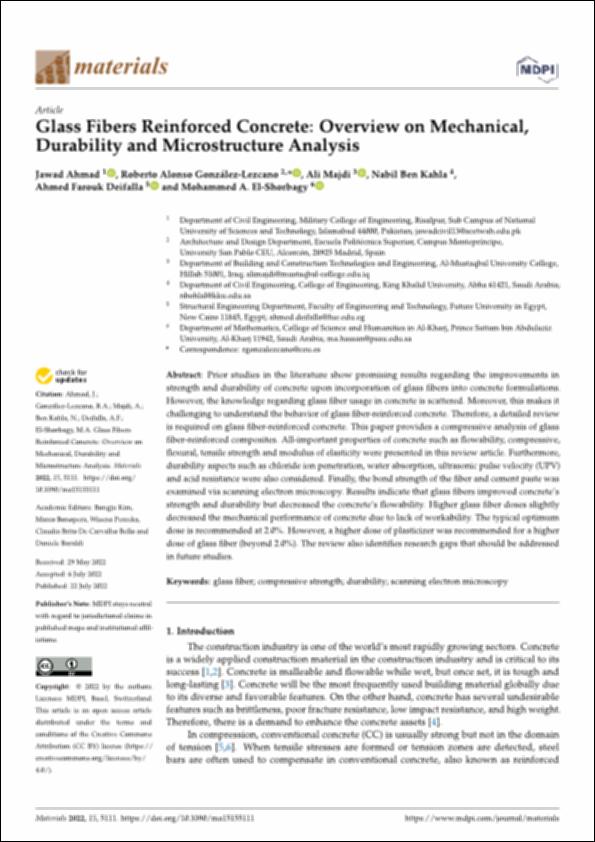Please use this identifier to cite or link to this item:
http://hdl.handle.net/10637/14551Glass Fibers Reinforced Concrete : Overview on Mechanical, Durability and Microstructure Analysis
| Title: | Glass Fibers Reinforced Concrete : Overview on Mechanical, Durability and Microstructure Analysis |
| Authors : | Ahmad, Jawad González Lezcano, Roberto Alonso. Majdi, Ali Ben Kahla, Nabil Farouk Deifalla, Ahmed El-Shorbagy, Mohammed A. |
| Keywords: | Glass fiber; Compressive strength; Durability; Scanning electron microscopy |
| Publisher: | MDPI |
| Citation: | Ahmad, J.; González-Lezcano, R.A.; Majdi, A.; Ben Kahla, N.; Deifalla, A.F.; El-Shorbagy, M.A. Glass Fibers Reinforced Concrete: Overview on Mechanical, Durability and Microstructure Analysis. Materials 2022, 15, 5111. https://doi.org/ 10.3390/ma15155111 |
| Abstract: | Prior studies in the literature show promising results regarding the improvements in strength and durability of concrete upon incorporation of glass fibers into concrete formulations. However, the knowledge regarding glass fiber usage in concrete is scattered. Moreover, this makes it challenging to understand the behavior of glass fiber-reinforced concrete. Therefore, a detailed review is required on glass fiber-reinforced concrete. This paper provides a compressive analysis of glass fiber-reinforced composites. All-important properties of concrete such as flowability, compressive, flexural, tensile strength and modulus of elasticity were presented in this review article. Furthermore, durability aspects such as chloride ion penetration, water absorption, ultrasonic pulse velocity (UPV) and acid resistance were also considered. Finally, the bond strength of the fiber and cement paste was examined via scanning electron microscopy. Results indicate that glass fibers improved concrete’s strength and durability but decreased the concrete’s flowability. Higher glass fiber doses slightly decreased the mechanical performance of concrete due to lack of workability. The typical optimum dose is recommended at 2.0%. However, a higher dose of plasticizer was recommended for a higher dose of glass fiber (beyond 2.0%). The review also identifies research gaps that should be addressed in future studies. |
| URI: | http://hdl.handle.net/10637/14551 |
| Rights : | http://creativecommons.org/licenses/by-nc-nd/4.0/deed.es openAccess |
| Issue Date: | 22-Jul-2022 |
| Center : | Universidad San Pablo-CEU |
| Appears in Collections: | Escuela de Politécnica Superior |
Items in DSpace are protected by copyright, with all rights reserved, unless otherwise indicated.


